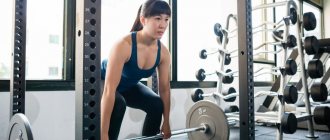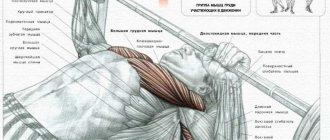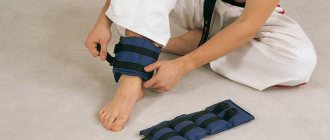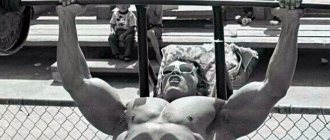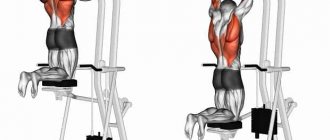Fitness and BodybuildingTips and Tricks
Do low rep sets really build strength? What about high rep sets? Is pumping useful for pumping up muscles? In this article we will answer all your questions regarding the number of repetitions.
Author:
Cliff Wilson
I remember the first time in my life I picked up a bodybuilding magazine. I was interested in how to properly train and build muscles. A complete layman in iron sports at that time, I was ready to absorb, like a sponge, any information from the magazine. It contained an article about the training of a professional bodybuilder (IFBB member), whose name makes no sense. The article described this athlete's favorite training program and the reasons why he liked it.
In one phrase I found the answer to the question that interested me. This bodybuilder said: “When I'm bulking, I lift heavy weights for low reps, and when it's time to cut, I lift light weights for high reps. This is the best way to burn fat." I decided that this was true, because the guy was big and prominent.
In the process of getting to know the world of bodybuilding, I have heard this “truth” more than once. Having an inquisitive mind and a thirst for knowledge, I soon discovered that the common statement about a small number of repetitions for mass and a large number for relief is very far from reality. As it turns out, in bodybuilding circles the truth about the number of repetitions is shrouded in darkness.
I have experience working with clients of varying fitness levels. Some of them seriously trained and competed, others were just starting their journey in the world of bodybuilding. I was surprised to notice that all my students, despite their level of training, misunderstood this simple question.
It's time to end this! I want to put everything in its place. Perhaps what I am about to tell you now will not become a sensation for experienced bodybuilders. However, everyone who steps into the gym should know this.
Low reps
Low reps include approaches consisting of 1-5 repetitions. It is believed that low-rep sets use fast-twitch muscle fibers, while high-rep sets use slow-twitch muscle fibers. Another misconception about the number of repetitions. In fact, low-rep sets work ALL muscle fibers - from slow to fast (including intermediate ones).
The body recruits muscle fibers (slow - intermediate - fast) as needed. When a muscle is under load, the slow muscle fibers are the first to engage. If slow-twitch fibers fail to develop enough force to lift a weight, intermediate fibers assist.
If slow and intermediate muscle fibers cannot cope with the load or become tired, the body mobilizes fast fibers. Muscle fibers are not partially or half used. The muscle fiber contracts at its maximum amplitude (Saladin, 2007). That is, when working with heavy weights, both slow and intermediate muscle fibers receive load.
In addition, low-repetition sets are effective in stimulating myofiber hypertrophy.
Myofibril hypertrophy
is an increase in the number and size of actin and myosin filaments in muscle tissue. Due to an increase in the number of tissues capable of contraction, this type of hypertrophy is characterized by an increase in strength indicators (Zatsiorski, 2006). This is an important point because consistently increasing weights is the main factor in building muscle mass in the long term. As you can see, performing low-repetition approaches with heavy weights is the key to huge muscles.
Which is better, high reps or low reps in bodybuilding?
Each system, type of training and technique bears fruit, like any physical activity. However, taking into account the individuality of athletes (different ratios of fast and slow fibers, anthropometry and other factors), it is impossible to predict the result in advance.
Therefore, the most optimal approach for muscle growth is alternating different types of training. This allows you not only to avoid muscular adaptation and “getting used to” loads, but also to find out what type of body an athlete responds to most effectively. If you evaluate the training of advanced athletes and professionals, you can increasingly see a tendency towards high-repetition sets.
Average number of repetitions
This includes sets of 6-12 repetitions. A number of scientific studies confirm the fact that the average number of repetitions helps to increase muscle size. The effectiveness of approaches with a medium number of repetitions is explained simply - they are universal.
In other words, it combines the benefits of both low-rep and high-rep sets. Muscles have to work with relatively larger weights, spending more time under load. Heavy weights stimulate the synthesis of myofibrillar proteins, which, as mentioned above, lead to an increase in the size of contractile proteins. Increasing the time under load activates sarcoplasmic hypertrophy.
Sarcoplasmic hypertrophy
is an increase in the volume of sarcoplasm and the size of supporting proteins in muscle cells that occurs as a result of lifting light weights for high repetitions. This type of muscle growth (which typically does not involve an increase in strength) explains why bodybuilders look more toned compared to powerlifters and strength athletes.
Medium rep training also produces excellent muscle pumps. Despite the fact that pumping is usually considered as a short-term effect of training, there is a possibility of its effect on increasing muscle mass. The results of scientific research show that an increase in cell size leads to both an increase in the rate of protein synthesis and a decrease in the rate of their breakdown.
So, while low-rep sets with heavy weights best stimulate myofibril hypertrophy, and high-rep sets with light weights best stimulate sarcoplasmic hypertrophy, then medium-rep sets occupy the “sweet spot” - they provide hypertrophy of both myofibers and sarcoplasm. Given the scientific facts, it is extremely unwise to eliminate medium-rep sets from your training program.
High number of repetitions
High repetition sets are those consisting of 15 or more repetitions. There is an ongoing debate in the lifting world that if low rep sets stimulate all muscle fibers, and moderate rep sets promote sarcoplasmic protein synthesis, then high rep sets are completely useless. At first glance, this statement seems logical. However, it does not take into account one very important factor. We are talking about the effect of glycogen on protein synthesis.
Glycogen
- This is the main form of glucose storage in muscle cells. Glycogen is a hydrophilic polysaccharide. It helps to increase muscle cells, because... There are 2.7 grams of water for every gram of glycogen (Chen et al. 1982).
I am sure that many of you will say: “Why do my muscles need water?” In addition to increasing muscle size, additional water volume also speeds up protein synthesis.
Many people don't realize that hydrating your cells is a very powerful trigger for muscle growth. Protein synthesis, as a rule, directly depends on the level of cellular hydration. In response to increased hydration, cells initiate a signaling cascade that stimulates muscle growth for self-defense.
What does all this theory have to do with high repetition training? High repetition sets dramatically reduce glycogen stores. As paradoxical as it may seem, the body, reacting to such a decrease, begins to increase glycogen reserves in the muscles. In the long term, this leads to cell stretching, an increase in overall muscle volume and the release of anabolic hormones.
In addition to all the benefits listed above, high-repetition training provides occlusion (blocking) of blood flow. As a result, blood is retained in areas under stress, which promotes muscle growth by increasing growth factor production and possibly satellite cell fusion (Vierck et al. 2000).
How many approaches should a natural athlete do per muscle group?
The athlete’s body will spend too many resources and will recover worse. Proponents of high-volume training believe that to gain mass, you need to do an average of three to four exercises per muscle group with a total number of approaches from 8 to 12 (sometimes higher).
Interesting materials:
How to clean stainless steel products? How to clean tiles in the kitchen? How to clean plaque from bathroom tiles? How to clean tiles in the bathroom? How to clean a Delonghi capsule coffee machine? How to clean a cashmere coat? How to clean aluminum pans? How to clean art brushes? How to clean a coffee machine with tablets? How to clean a delonghi coffee maker?
Comparison of techniques
So, we have learned what training with low, medium and high repetitions is used for. But that is not all. To correctly apply this knowledge in practice, you need to be able to understand it. Let's take a closer look.
Despite all of the above, some athletes argue that high-rep exercises are pointless and that low- and medium-rep training should be preferred, focusing solely on increasing the working weights. A recent study shows that this is absolutely not the case.
The study involved 15 young people who performed leg extensions in a machine in two different ways. Scientists compared the efficiency of protein synthesis in 4 approaches with 90% RM before failure and in 4 approaches with 30% RM before failure. As a result, high-repetition exercise was found to promote greater protein synthesis (Bjord et al. 2010). In other words, the popular belief about low rep sets for mass and high rep sets for terrain is completely wrong.
At the same time, high-repetition training has one problem that should not be forgotten. As mentioned above, high-repetition exercises do not increase strength. Building muscle mass is achieved only with a constant increase in working weights. Hence the conclusion: although high-repetition training is effective in the short term, the absence of a constant increase in resistance inevitably leads to stagnation.
However, there is one way to avoid stagnation. By training with heavy weights for low to moderate repetitions, we develop strength. The increase in strength in 1-5 repetitions is provided by the so-called. "gradual stimulation effect". That is, if we have become stronger in 1-5 repetitions, then the weights will increase in high-repetition approaches. By increasing your deadlift rep max from 115 kg to 160 kg, you will be able to lift heavier weights for 20 reps. This is the essence of the effect of gradual stimulation of strength.
As a result, using low, medium and high repetition approaches produces a synergistic effect. Low-rep, medium-rep and high-rep training methods are not mutually independent. Improving results in one direction leads to improved results in other directions. Without understanding this process, it is impossible to see the full composition of strength training.
conclusions
From everything discussed in this article, two conclusions can be drawn.
- Low-, medium-, and high-repetition training methods help build muscle mass, but they do it in different ways. Thus, all of them should be presented in training programs (both during periods of “mass” and “cutting”).
- Don't use high rep training to burn fat. Strength training speeds up your metabolism and calorie expenditure. None of the strength training methods can provide an effective fight against extra pounds. Only proper nutrition and cardio training destroy fat deposits, making your figure sculpted. Strength training makes muscles, diet makes you lean.
As you can see, by changing the number of repetitions it is impossible to get rid of fat or achieve muscle definition. The thesis about the inability of high-repetition training to build pure muscle mass is also not confirmed. Whether your goals are to prepare for a performance by losing a few pounds or to gain as much muscle as possible, you need to use sets with varying numbers of repetitions. Only this technique will give the maximum results that your body is capable of. How can everything discussed above be used in practice? Depends on how many times a week you train each muscle group - once or twice.
If you train each muscle group once a week, then the optimal training program, including sets with different numbers of repetitions, will look like this:
- First 1-2 exercises (basic):
3-4 sets with heavy weights in 1-5 repetitions. - Next 1-2 exercises (basic):
3-4 sets with medium weights for 8-12 reps. - Final 1-2 exercises (isolation):
3-4 sets with light weights in 15-30 repetitions.
Training each muscle group twice a week allows you to specialize and focus on one type of training or another. This is why I typically recommend more frequent training to my clients. Here's a good example of a split:
Workout 1
- First 1-2 exercises (basic):
3-4 sets with heavy weights in 2-4 repetitions. - Next 1-2 exercises (basic):
3-4 sets with medium weights for 4-6 reps. - Final 1-2 exercises (isolation):
3-4 sets with light weights in 6-8 repetitions.
Workout 2
- First 1-2 exercises (basic):
3-4 sets with heavy weights in 12-15 repetitions. - Next 1-2 exercises (basic):
3-4 sets with medium weights for 15-20 repetitions. - Final 1-2 exercises (isolation):
3-4 sets with light weights in 25-30 repetitions.
The world of bodybuilding is rife with misconceptions and misconceptions. Any issue should be considered from all points of view. It's not just the guy at the gym who thinks he's a star who can talk nonsense. Even members of the bodybuilding elite often have inaccurate information.
I always say that no matter what method you use in training or nutrition, you need to ask yourself the question: “Why am I doing this?” If you can't give a clear, fact-based answer, then it's time to reconsider your approach to training. The once widespread postulates about the number of repetitions have long since sunk into the past.
In short, lift heavy weights, give it 100%, and pump up your muscles with high reps. Only then will there be real growth!
About the number of approaches, repetitions and weights... Or how muscles grow?
Originally the material “About the number of approaches, repetitions and weights... Or how muscles grow?” was split into several posts on my Instagram. For those who missed something or simply want to receive information in a detailed and structured form, this article has been prepared.
Let me start with the fact that muscle tissue consists of:
- myofibrils - fiber that provides contraction;
- sarcoplasm - everything else that makes up muscles: water, glycogen, minerals, globular proteins, triglycerides...
For clarity, the photo below shows a schematic representation of muscle fiber and how it can increase, that is, hypertrophy due to an increase in the number of myofibrils or the growth of sarcoplasm.
In one case, muscle hypertrophy occurs due to an increase in sarcoplasm . That is, we train and over time our reserves of glycogen (carbohydrates) in our muscles grow, and 1 g. carbohydrates attracts 3 grams. water, capillary networks increase, reserves of other nutrients increase... As a result, the muscle visually increases in volume, but the number of contractile elements (myofibrils) does not increase, and accordingly, strength does not grow linearly with muscle growth . The primary stimulus for sarcoplasmic hypertrophy is high-repetition training, which depletes muscle energy reserves.
In another case, muscle hypertrophy occurs due to an increase in myofibrils , that is, the contractile filaments and fibers themselves. They are the “engine” that moves our muscles. The main stimulus for myofibrillar hypertrophy is heavy, strength training , where we perform repetitions (1-5 reps) at or near maximum weight.
But this is a theory. Usually it is with its help that they try to explain the difference in strength between bodybuilders and powerlifters. Something like the fact that in some people sarcoplasmic hypertrophy predominates to a greater extent, so visually bodybuilders are so muscular, but still not as strong as powerlifters with smaller muscle volumes. Indeed, some studies indirectly confirm this theory, but I have not found 100% evidence.
What is “heavy weight” or “working weight”?
I read your comments on Instagram and decided to clarify a little:
— What is “heavy weight”?
Let's say my maximum weight in a squat is 100 kg, that is, I can squat with a weight of 100 kg for one repetition maximum - usually this is called 1RM ( one-repetition maximum or 1RM in English). Your 1RM (one rep max or max/record weight for one rep) is a “heavy weight”, and lifting weights at 80-100% of your 1RM is working with “heavy weights” and a small number of repetitions (1-6 reps) in the approach). Following the principle of “load progression,” your 1RM will increase over time as your muscles adapt to the load.
The classic bodybuilding style is 12 repetitions with a weight of about 70% of 1RM (or, starting from the example above, 70 kg for 12 repetitions per set). Typically, a weight around 70% of 1RM is called the “working weight.” Training in the gym can be based on the following approach - first we perform 1 approach with a “ warm-up weight ” (20% of 1RM or, starting from the example above, 20 kg, that is, we squat with an empty bar) for 20 repetitions to warm up the muscles, ligaments, joints . Then you can choose either the “ pyramid ” principle, or immediately proceed to the “ working scales ”:
- “ Pyramid principle ” - after completing the warm-up approach, we gradually increase the weight, i.e. 2 approach with a weight of 40% of 1RM for 12 repetitions, 3 approach with a weight of 60-70% of 1RM for 12 repetitions, 4 approach with a weight of 80-100% of 1RM and try to do the maximum possible number of repetitions, slightly improve the result of the previous workout ( element of “load progression”)
- “ Working weights ” - after completing the warm-up approach, we increase the weight to “ working ”, i.e. 2, 3 and 4 sets with a weight of about 70% of 1RM for 12 reps. In this approach, there is no work with “ heavy weights ”, and accordingly the risk of injury is reduced.
I recommend trying both the “pyramid” style and the same type of work with the same weight and the same number of repetitions.
Working with very light weights (30% of 1RM) and a large number of repetitions, we do not “burn” the muscles and do not “dry” anything, but simply include a smaller number of muscle fibers in the work and use a different type of energy supply.
Types of muscle fibers (MF) and their energy supply.
There are several classifications, but I will try to briefly outline the essence. MVs are distinguished by the type of energy supply:
- glycolytic - those that use glycogen (glucose stores in muscles) as an energy source and work without oxygen (anaerobic work). They work for a short time (about a minute), but have the greatest power. For example, this is any “explosive” work - running 100 meters, working with weights from 70% of 1RM, etc.
- oxidative - those that use fat as an energy source. Don’t rush to rejoice here; they do not use subcutaneous fat, but the fat that is inside the CF. Oxidative oxygen is required for the work of oxidative MVs (aerobic work). These MVs do not have high power, but they are capable of operating for a long time.
I think everyone is still interested in the question about fat? For example, you went for a light jog, but after another hour you felt tired and sat down to rest. Why? After all, there is enough fat in the body, why doesn’t the body use it as a source? The fact is that the CF has spent the fat that was inside them and now it will take time for the subcutaneous fat to enter the bloodstream, be transported to the CF and you will have energy. But the more trained a person is, the more CF he has, the more fat he can “utilize”/“burn” during a workout.
I will say that both during the marathon and during the sprint we have all types of CF , but in different proportions (see the picture, where the “red” ones are oxidative, and the “white” ones (although they seem to be pink


